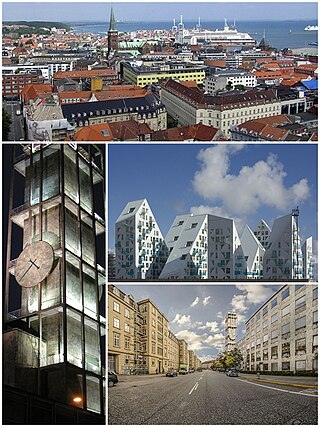
Aarhus is the second-largest city in Denmark and the seat of Aarhus Municipality. It is located on the eastern shore of Jutland in the Kattegat sea and approximately 187 kilometres (116 mi) northwest of Copenhagen.

Michael Gottlieb Birckner Bindesbøll was a Danish architect active during the Danish Golden Age in the first half of the 19th century. Most known for his design of Thorvaldsens Museum in Copenhagen, he was a key figure in the stylistic shift in Danish architecture from late classicism to Historicism. He was the father of the designer Thorvald Bindesbøll and the textile artist Johanne Bindesbøll.
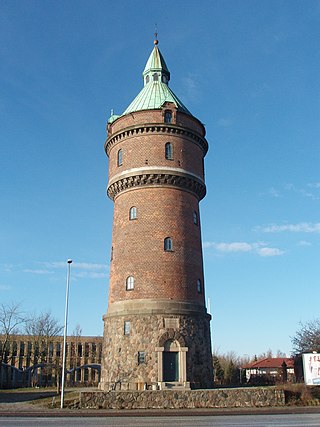
Aarhus N is a postal district in the city of Aarhus, consisting of Trøjborg, Risskov, Vejlby, Skejby, Vorrevangen and Christiansbjerg, all with postal code 8200. Aarhus N is an abbreviation for Aarhus Nord and is located north of the city centre. It is the highest lying area of Aarhus.

Aarhus University Hospital (AUH) is a university hospital located in Aarhus, Denmark. The hospital develops and provides highly specialised medical treatment, research and education at an international level. The university hospital's headquarters and main department, known as The New University Hospital (DNU), is the largest single hospital in Denmark and one of the largest in Europe.

Sandviken Hospital is a psychiatric hospital situated in the Sandviken neighborhood of Bergen, Norway. It is part of Bergen Hospital Trust, and is the only secure psychiatric unit within Western Norway Regional Health Authority.
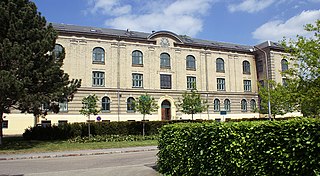
Sankt Hans Hospital is a psychiatric hospital in Roskilde on the Danish island of Zealand, 30 km from Copenhagen. Although situated in the Zealand Region, it is owned by the Capital Region and serves patients from that region. The land was bought by the forerunner of Copenhagen Municipality at the beginning of the 1800s so it could relocate the municipality's psychiatric hospital to a more rural location. With a history beginning in 1620, the hospital now has 180 beds and offers specialized treatment in the areas of forensic psychiatry and dual diagnosis.
Vejlby-Risskov Idrætscenter is a sports complex located in Aarhus, Denmark. It is the largest of its kind in East Jutland. The complex is situated in the district of Vejlby-Risskov in the northern part of Aarhus. Its central parts consist of Vejlby Stadium, home ground of association football club VSK Aarhus, and Vejlby-Risskov Hallen, the home of basketball team Bakken Bears.
The following is a timeline of the history of the city of Aarhus, a city in central Denmark.

Museum Ovartaci in Aarhus, Denmark is a combined art and historical museum dedicated to the history of psychiatric treatment and art produced by patients at the Risskov Psychiatric Hospital. It was a part of Aarhus University Hospital in the same buildings as the Psychiatric Hospital in Risskov, but now it is located on Katrinebjergvej in Aarhus N. The museum also offers social programmes directed at psychiatric patients, including an open atelier, creative workshops and a café.

Aarhus Old City Hall is the former city hall of Aarhus, Denmark, and a listed building. The city hall was built in 1857 and was listed in the Danish national registry of protected buildings and places by the Danish Heritage Agency on 18 March 1996. It is the second, and oldest preserved, city hall of Aarhus.
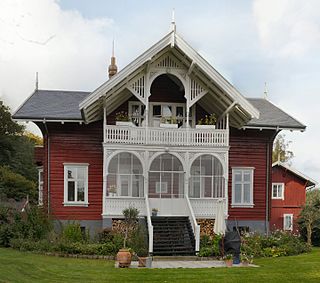
Det Norske Hus is a listed building in Aarhus, Denmark. The house was first built in 1888 and it was listed in the Danish national registry of protected buildings and places by the Danish Heritage Agency on 14 October 1996. The house is situated on the northern border of Riis Skov in the northern neighbourhood Risskov. The building is today privately owned and used as a home.

Aarhus Craftsmen's Association's Asylum is a listed building and a former asylum in Aarhus, Denmark. The building was finished in 1866 and was listed in the Danish national registry of protected buildings and places by the Danish Heritage Agency on 27 September 1980. The building is situated on Paradisgade in the central Indre by neighbourhood.

The Aarhus Central Workshops is a complex of listed buildings in Aarhus, Denmark and is the former DSB central train repair facility for Jutland and Fuenen. The buildings were completed in 1862 and was listed by the Danish Heritage Agency in the Danish national registry of protected buildings and places on 11 November 2005. The complex includes the central workshop building and the smithy (Smedjen). The building complex is situated in the central Indre By neighborhood close to the Aarhus Central Station.
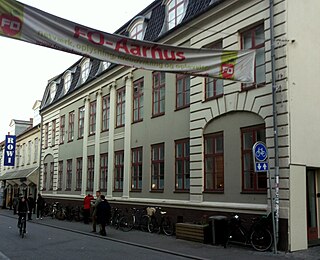
Herskind's House is a house and a listed building in Aarhus, Denmark. The house was built in approximately 1850 and was listed on the Danish registry of protected buildings and places by the Danish Heritage Agency on 2 October 1970. The house is situated in the historic Indre by neighborhood on Frederiksgade, close to the City Hall.

Mejlgade is a street in Aarhus which runs north to south from Østbanetorvet to Skolegade and intersects Nørrebrogade. The street is situated in the historic Latin Quarter neighborhood and has the highest number of historic and listed buildings in the city. Mejlgade is one-way and no-parking zone for cars for most of its length and pedestrians and cyclists are given priority. The single lane is tiled and a part of the Cykelringen bicycle ring which circumnavigates the city center. Mejlgade has a high number of small specialty shops and some cafés and bars.

Carl Georg Ferdinand Thielemann was a Danish architect and royal building inspector during the 19th century. Thielemann was the brother of sculptors Christian and Theobald Thielemann and was born in Copenhagen. He studied architecture in 1819–20 at the Royal Danish Academy of Fine Arts under the tutelage of Christian Frederik Hansen. Thielemann was mainly taught the Neoclassical style but during the 1880s Historicism flourished and he adapted to the new style. After graduation Thielemann worked for Christian Frederik Hansen and Gustav Friedrich Hetsch as a conductor for their projects.

Aarhus County Hospital, or Aarhus Sygehus, Tage-Hansens Gade, was a hospital in Aarhus for 136 years, from 1882 to 2018. The hospital became a part of Aarhus University Hospital in 2011 in an administrative merger. In 2018, all hospital functions at Aarhus County Hospital were relocated to The New University Hospital (DNU) in Skejby in northern Aarhus.

Frederiksgade is a street in the Indre By district in Aarhus, Denmark which runs north to south from Åboulevarden to Frederiks Allé. Frederiksgade is a major thoroughfare for pedestrians and cyclists and it connects Immervad to ARoS Aarhus Art Museum and the City Hall and Concert Hall parks. The street is fairly narrow and the architecture is primarily late 19th century to early 20th century.
The 1926–27 JBUs Mesterskabsrække was the 29th season of the Jutland Football Championship since its establishment in 1902, and the 5th season since the regional top-flight league was rebranded and reorganised from JBUs A-Række to the JBUs Mesterskabsrække. The season was launched on 12 September 1926 and concluded on 8 May 1927 with the final match of the regular league fixtures, while the two-legged championship play-off and the promotion/relegation play-off matches were held between 15 May and 12 June 1927. Horsens FS secured their second consecutive Jutland league championship and qualified for both the provincial semi-finals of the 1926–27 Landsfodboldturneringen and the group stage of the 1927–28 Danmarksmesterskabsturneringen. Horsens FS' reserve team were relegated and replaced by Kolding BK of the 1926–27 JBUs A-række, who had won the regional second-tier league championship. In the 1926 JBUs Pokalturnering, Aalborg BK obtained their third consecutive cup championship, by winning the final against Esbjerg fB.
Stege Town Hall, situated at the corner of Rådhusgade and Storegade, is the former town hall of Stege on Møn, now part of Vordingborg Municipality, in southeastern Denmark. The Renaissance Revival style building was completed in 1854 to designs by Gottlieb Bindesbøll and served its original purpose for just over one hundred years. It was subsequently used as police station from 1968 to 2008. The building was listed on the Danish registry of protected buildings and places in 1979.



















